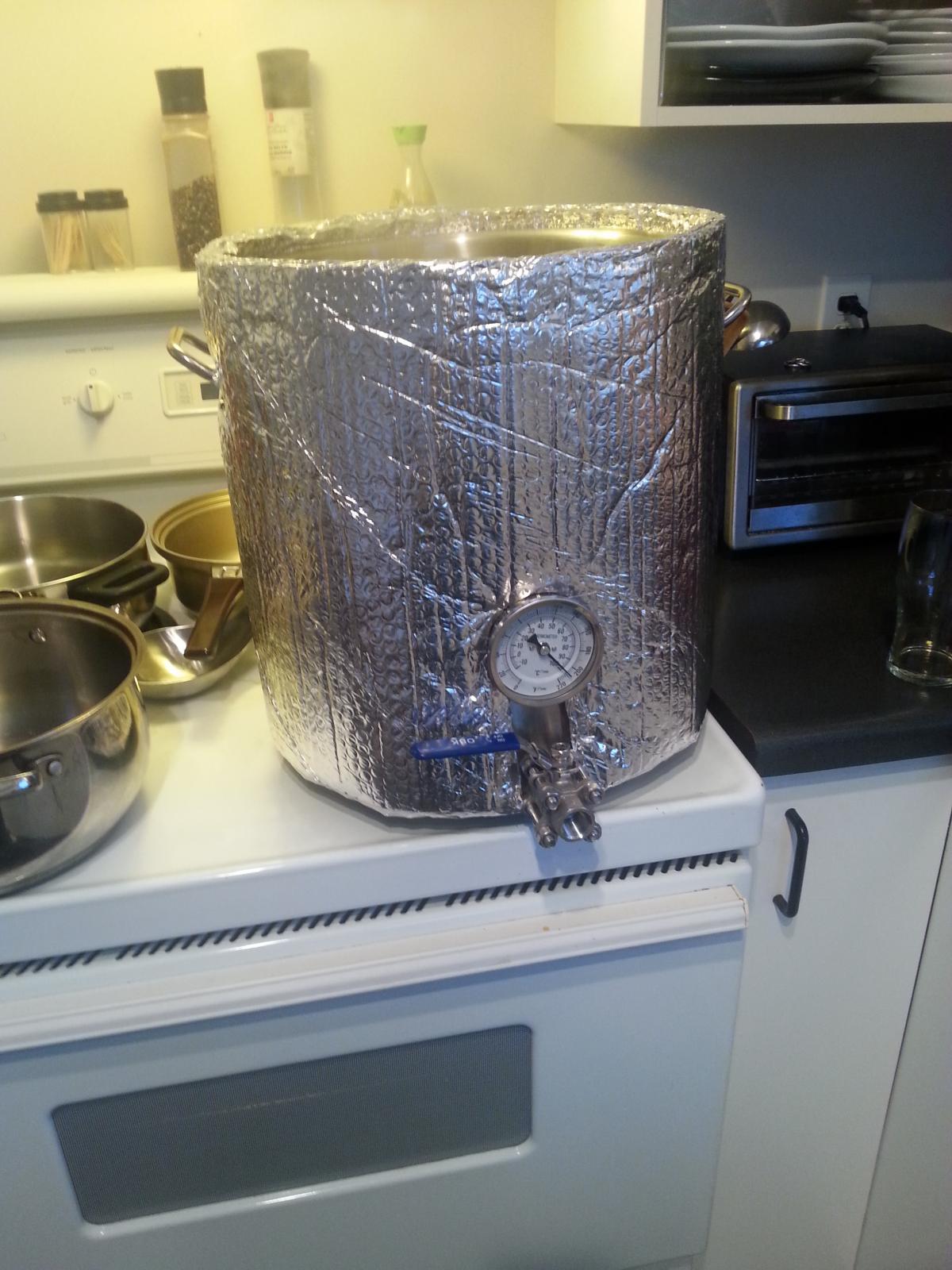Hi all!
Many of us are stuck brewing on our standard electric range. I was having problems getting a strong boil even on my smallest batches of 7.5L (2Gal), and was investigating options such as installing an extra burner in the side of my pot, using an immersion bucket heater, etc.
After reading some things on this forum I decided to try two options
- line my drop pan with foil to, supposedly, reflect the IR back up and be more efficient (I was highly dubious)
- create an insulating jacket for my kettle (seemed reasonable).
I did both, and did comparisons, so here are the results!
Equipment
- 8 gal tallboy (http://www.brewnorth.com/products/8-gallon-tall-boy-kettle-1)
- 2400 watt large burner on a standard 220v range (I measured with a multimeter)
- kettle jacket: AYR Foil (A2A), rated up to 120c so should be kettle-safe, but not flame/burner safe.. I double layered this, made a nice tight fit, and used foil tape to trim the edges (see photo)
Process
- start with a completely cold stove and kettle. Fill with ground water temperature (pretty consistent over the last week). Put on MAX. Time until full boil. I used 11L of water.
Conditions!
- benchmark - just the kettle on the burner as always
- pan - line the drip pan with regular aluminum foil, shiny side up
- jacket - put the jacket on the kettle
- pan and jacket - both the drip pan and the jacket on.
Results!
- benchmark: 49 minutes
- pan: 39 minutes
- jacket: 47 minutes
- pan and jacket - 37 minutes
Analysis ( OK, this isn't real science, but still!)
OK, this isn't real science, but still!)
Looks to me like lining the drip pan made a real big difference. When I saw the only 2 minute gain with the jacket only condition, I assumed it was just random noise in the procedure, but it's interesting that the pan and jacket was also 2 minutes faster than pan only.
I started this because my 7.5L batches were not boiling well. Yesterday, I made a 15L batch, and the full boil volume had a very violent boil on the go - I used the pan and the jacket. Although the pan in my test performed better than the jacket, my guess is that for larger volumes and for longer times the jacket's impact will be stronger.
I'll also add that, anecdotally, my stove top was not nearly as hot as usual when it was done.
Well that's that! for pennies in foil you can really up the heat on your pot. And for about $10 in foil insulation, you can get an extra edge (and make your mash more stable if you BIAB!). I see no reason now to upgrade to a 2800 watt element or a canning element.

Many of us are stuck brewing on our standard electric range. I was having problems getting a strong boil even on my smallest batches of 7.5L (2Gal), and was investigating options such as installing an extra burner in the side of my pot, using an immersion bucket heater, etc.
After reading some things on this forum I decided to try two options
- line my drop pan with foil to, supposedly, reflect the IR back up and be more efficient (I was highly dubious)
- create an insulating jacket for my kettle (seemed reasonable).
I did both, and did comparisons, so here are the results!
Equipment
- 8 gal tallboy (http://www.brewnorth.com/products/8-gallon-tall-boy-kettle-1)
- 2400 watt large burner on a standard 220v range (I measured with a multimeter)
- kettle jacket: AYR Foil (A2A), rated up to 120c so should be kettle-safe, but not flame/burner safe.. I double layered this, made a nice tight fit, and used foil tape to trim the edges (see photo)
Process
- start with a completely cold stove and kettle. Fill with ground water temperature (pretty consistent over the last week). Put on MAX. Time until full boil. I used 11L of water.
Conditions!
- benchmark - just the kettle on the burner as always
- pan - line the drip pan with regular aluminum foil, shiny side up
- jacket - put the jacket on the kettle
- pan and jacket - both the drip pan and the jacket on.
Results!
- benchmark: 49 minutes
- pan: 39 minutes
- jacket: 47 minutes
- pan and jacket - 37 minutes
Analysis (
Looks to me like lining the drip pan made a real big difference. When I saw the only 2 minute gain with the jacket only condition, I assumed it was just random noise in the procedure, but it's interesting that the pan and jacket was also 2 minutes faster than pan only.
I started this because my 7.5L batches were not boiling well. Yesterday, I made a 15L batch, and the full boil volume had a very violent boil on the go - I used the pan and the jacket. Although the pan in my test performed better than the jacket, my guess is that for larger volumes and for longer times the jacket's impact will be stronger.
I'll also add that, anecdotally, my stove top was not nearly as hot as usual when it was done.
Well that's that! for pennies in foil you can really up the heat on your pot. And for about $10 in foil insulation, you can get an extra edge (and make your mash more stable if you BIAB!). I see no reason now to upgrade to a 2800 watt element or a canning element.



